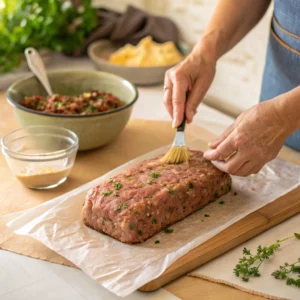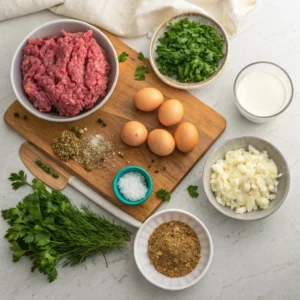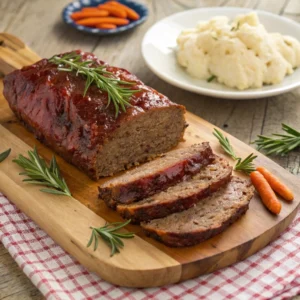Introduction to the Deer Meatloaf Recipe
 Venison, or deer meat, is a popular choice among hunters and those seeking healthier red meat alternatives. Leaner than beef and packed with protein, venison offers a mild yet distinctive flavor that pairs beautifully with classic meatloaf ingredients. Its lower fat content makes it an excellent option for health-conscious eaters, but it also requires careful preparation to keep it moist and tender. In this recipe, we combine ground venison with simple, flavorful seasonings and ingredients to create a juicy, mouthwatering meatloaf that highlights the natural richness of the meat.
Venison, or deer meat, is a popular choice among hunters and those seeking healthier red meat alternatives. Leaner than beef and packed with protein, venison offers a mild yet distinctive flavor that pairs beautifully with classic meatloaf ingredients. Its lower fat content makes it an excellent option for health-conscious eaters, but it also requires careful preparation to keep it moist and tender. In this recipe, we combine ground venison with simple, flavorful seasonings and ingredients to create a juicy, mouthwatering meatloaf that highlights the natural richness of the meat.
This deer meatloaf recipe is a healthier take on classic meatloaf, offering tender, flavorful results with every bite.
Why Choose Venison for Meatloaf?
Venison is an excellent choice for meatloaf due to its lean, nutrient-rich composition and unique flavor. Unlike traditional beef or pork, venison provides a healthier alternative while delivering a satisfying, hearty dish. It’s a popular option for hunters and those who enjoy locally sourced, sustainable meat. Additionally, venison’s versatility allows it to pair perfectly with herbs, spices, and other ingredients, resulting in a flavorful, moist meatloaf that’s both nutritious and delicious. If you’re looking to elevate a classic comfort food, venison is the perfect ingredient.
Nutritional Benefits of Venison
Venison is not only leaner than beef but also lower in calories and saturated fat, making it a healthier red meat option. It’s packed with protein, iron, and essential vitamins like B12, which support energy production and overall health. Venison is also a great source of zinc and niacin, important for immune function and metabolism. For those on a high-protein or low-fat diet, venison provides the perfect balance of nutrition without compromising on taste.
Venison Flavor Profile Compared to Other Meats
Venison has a distinctive yet mild flavor compared to beef or lamb. While beef tends to be fattier and richer, venison offers a clean, earthy taste that reflects its natural diet of grasses and wild plants. It is often described as slightly gamey, but when prepared properly, it’s tender and flavorful without being overwhelming. Unlike pork or chicken, venison’s lean texture makes it ideal for absorbing spices and seasonings, creating a perfectly balanced and unique meatloaf experience.
Essential Ingredients for a Moist Deer Meatloaf Recipe
 Creating a perfectly moist and flavorful venison meatloaf requires a careful balance of ingredients. Since venison is naturally leaner than beef, it’s essential to add moisture and binding components to keep the texture tender. Key ingredients include ground venison, binding agents like breadcrumbs and eggs, and fat additions such as bacon or beef fat. Seasonings, herbs, and sauces play a crucial role in enhancing the natural flavors of the meat while ensuring a delicious outcome. With the right combination, you can make a venison meatloaf that is juicy, hearty, and packed with flavor.
Creating a perfectly moist and flavorful venison meatloaf requires a careful balance of ingredients. Since venison is naturally leaner than beef, it’s essential to add moisture and binding components to keep the texture tender. Key ingredients include ground venison, binding agents like breadcrumbs and eggs, and fat additions such as bacon or beef fat. Seasonings, herbs, and sauces play a crucial role in enhancing the natural flavors of the meat while ensuring a delicious outcome. With the right combination, you can make a venison meatloaf that is juicy, hearty, and packed with flavor.
The key to a successful deer meatloaf recipe lies in selecting the right ingredients to ensure moisture and flavor.
Choosing the Right Ground Venison for Your Deer Meatloaf Recipe
When selecting ground venison for meatloaf, aim for meat that is finely ground and freshly processed. Venison is naturally lean, so consider asking your butcher to mix it with a small percentage of beef fat or pork fat for added juiciness. If you’re grinding venison yourself, opt for cuts from the shoulder or neck, as they provide a good texture for meatloaf. Avoid over-processed or old venison, as it can result in a dry, tough dish.
Binding Agents to Perfect Your Deer Meatloaf Recipe
Binding agents like eggs, breadcrumbs, and milk are crucial for holding the meatloaf together while adding moisture. Eggs provide structure and bind the meat, while breadcrumbs (or crushed crackers) absorb liquid, preventing the meatloaf from becoming dense. Adding a splash of milk softens the breadcrumbs, creating a tender, moist interior. These ingredients work together to ensure your meatloaf holds its shape while staying flavorful and juicy.
How to Add Fat to Prevent Dryness in Your Deer Meatloaf Recipe
Because venison is very lean, incorporating fat into the recipe is essential to prevent dryness. Popular options include mixing the venison with ground pork, beef fat, or adding finely chopped bacon. These fats not only improve the texture but also enhance the overall flavor of the meatloaf. Another technique is to layer bacon strips on top of the meatloaf during baking, allowing the fat to baste the meat and keep it moist.
Seasonings and Flavors for a Tasty Deer Meatloaf Recipe
Seasoning is the key to elevating venison’s natural flavor. Use a combination of salt, black pepper, garlic powder, and onion powder as a base. Fresh herbs like thyme, rosemary, and parsley add aromatic depth, while Worcestershire sauce or soy sauce enhances umami. For a bit of tang and moisture, consider adding ketchup, barbecue sauce, or a tomato-based glaze. These seasonings balance the earthiness of venison, delivering a well-rounded and savory meatloaf.
Step-by-Step Guide to Making the Perfect Deer Meatloaf Recipe
This step-by-step deer meatloaf recipe ensures a tender, flavorful, and perfectly cooked dish that highlights the natural taste of venison. By carefully combining the right ingredients, preparing the meat properly, and baking it with a flavorful glaze, you’ll achieve a moist and satisfying meatloaf that’s perfect for any occasion. Follow these simple steps to create a meatloaf your family and friends will love.
Follow this simple deer meatloaf recipe for perfect results every time.
Preparing the Ingredients for Your Deer Meatloaf Recipe
Start by gathering all your ingredients. You’ll need:
- 1 ½ pounds of ground venison (mixed with a bit of pork fat or beef fat for added moisture).
- 2 large eggs (for binding).
- 1 cup breadcrumbs (or crushed crackers).
- ½ cup milk (to soften the breadcrumbs).
- 1 small onion, finely chopped.
- 2 cloves garlic, minced.
- 2 tablespoons Worcestershire sauce (for depth of flavor).
- 1 teaspoon salt and ½ teaspoon black pepper.
- Optional fresh herbs like parsley or thyme for added aroma.
Measure and prepare everything before starting. Finely chop vegetables to ensure even cooking, and soften the breadcrumbs in milk to achieve a smooth consistency.
Mixing and Shaping Your Deer Meatloaf Recipe
- In a large mixing bowl, combine the ground venison, softened breadcrumbs, beaten eggs, milk, chopped onion, minced garlic, Worcestershire sauce, salt, pepper, and any herbs you’re using.
- Use your hands or a wooden spoon to mix everything gently. Be careful not to overwork the mixture, as this can result in a dense and tough meatloaf.
- Once mixed, shape the meat mixture into a loaf. Place it in a greased baking dish or on a parchment-lined baking sheet. If using a loaf pan, make sure there’s enough room for juices to collect without overflowing.
Baking the Deer Meatloaf Recipe to Perfection
- Preheat your oven to 375°F (190°C).
- Place the meatloaf in the preheated oven and bake for 45 to 55 minutes, depending on the thickness of your loaf.
- To ensure the meatloaf stays moist, avoid overbaking. Check for doneness using a meat thermometer—internal temperature should reach 160°F (71°C).
- If needed, tent the meatloaf with foil halfway through cooking to prevent the top from drying out.
Creating the Perfect Glaze for Your Deer Meatloaf Recipe
For a flavorful glaze, mix together:
- ½ cup ketchup
- 2 tablespoons brown sugar
- 1 tablespoon Worcestershire sauce
Brush the glaze over the top of the meatloaf during the last 15 minutes of baking. This creates a rich, tangy finish that complements the venison perfectly.
By following these steps, you’ll end up with a moist, flavorful deer meatloaf with a beautiful glaze—perfect for serving alongside mashed potatoes or roasted vegetables. Enjoy!
Tips to Improve Your Deer Meatloaf Recipe
 Achieving a juicy and flavorful deer meatloaf depends on balancing ingredients, cooking methods, and careful preparation. Because venison is naturally lean, it requires added moisture and fats to prevent dryness. Additionally, cooking times and temperatures play a crucial role in retaining the perfect texture and flavor. Follow these expert tips to ensure your venison meatloaf turns out tender, moist, and delicious every time.
Achieving a juicy and flavorful deer meatloaf depends on balancing ingredients, cooking methods, and careful preparation. Because venison is naturally lean, it requires added moisture and fats to prevent dryness. Additionally, cooking times and temperatures play a crucial role in retaining the perfect texture and flavor. Follow these expert tips to ensure your venison meatloaf turns out tender, moist, and delicious every time.
A well-crafted deer meatloaf recipe incorporates moisture-rich ingredients and careful cooking techniques.
How to Incorporate Moisture into the Deer Meatloaf Recipe
To combat the leanness of venison, it’s essential to incorporate moisture into your meatloaf. Start by adding ingredients like milk-soaked breadcrumbs or crushed crackers, which act as sponges, locking in juices during baking. Eggs help bind the ingredients while also contributing to a moist texture. Adding finely chopped vegetables like onions, carrots, or bell peppers can introduce natural moisture as they cook. For extra richness, mix in fats like ground pork, beef fat, or chopped bacon to ensure a juicy bite in every slice.
Avoid Overcooking Your Deer Meatloaf Recipe for Best Results
Overcooking is one of the main reasons venison meatloaf turns out dry. To prevent this, bake the meatloaf until it reaches an internal temperature of 160°F (71°C), as measured by a meat thermometer. Start checking the temperature around the 45-minute mark to avoid overbaking. Additionally, consider tenting the meatloaf with foil halfway through the cooking process to lock in moisture and prevent the top from drying out. Allowing the meatloaf to rest for 5-10 minutes after baking ensures the juices redistribute evenly, keeping every bite moist and flavorful.
Variations of Deer Meatloaf
Deer meatloaf is a versatile dish that can be adapted to suit different tastes and preferences. By experimenting with additional meats, vegetables, and seasonings, you can enhance both the texture and flavor of the meatloaf while ensuring it remains juicy and satisfying. These variations allow you to customize the recipe while complementing the natural richness of venison.
If you want to adapt this deer meatloaf recipe, try mixing venison with pork or adding sautéed vegetables for added flavor.
Mixing Venison with Other Meats (Beef or Pork)
Combining venison with other meats like beef or pork is a popular way to enhance flavor and add moisture. Beef provides a rich, hearty taste, while pork adds a bit of fat that venison naturally lacks. A common ratio is 2 parts venison to 1 part ground pork or beef, which balances the lean texture of venison without overpowering its earthy flavor. This mix ensures a juicy, tender meatloaf that holds together perfectly.
Adding Vegetables for Texture and Flavor
Incorporating finely chopped vegetables such as onions, carrots, bell peppers, or mushrooms adds both moisture and texture to the meatloaf. These vegetables soften during baking, releasing natural juices that prevent dryness while enhancing flavor with subtle sweetness and depth. For best results, sauté the vegetables briefly before mixing them into the meatloaf.
Common Mistakes to Avoid When Making Deer Meatloaf
Making deer meatloaf requires attention to detail to ensure it turns out tender, juicy, and flavorful. Avoiding common pitfalls like improper fat ratios, overmixing, or skipping crucial steps can make all the difference between a dry, dense loaf and a perfectly cooked masterpiece. Here are the key mistakes to watch out for.
Using the Wrong Fat Ratio
Venison is naturally lean, and using it without enough added fat can result in a dry meatloaf. To avoid this, mix venison with fattier meats like pork or beef, or incorporate fats like bacon or beef tallow. A 2:1 ratio of venison to fatty meat works well to maintain juiciness and texture.
Overmixing the Meat Mixture
Overmixing the meat mixture is a common mistake that can make the meatloaf dense and tough. Combine the ingredients gently until just mixed to avoid overworking the meat. Use your hands or a spoon to lightly incorporate everything while maintaining a tender texture.
Forgetting to Rest the Meatloaf
Skipping the resting period after baking can cause the juices to run out, leaving your meatloaf dry. Allow the meatloaf to rest for at least 5-10 minutes before slicing. This gives the juices time to redistribute, ensuring every bite is moist and flavorful.
Serving and Pairing Ideas for Your Deer Meatloaf Recipe
Deer meatloaf pairs beautifully with a variety of sides and sauces that complement its hearty, earthy flavor. Whether you stick to traditional pairings or explore unique sauces and gravies, the right accompaniments can elevate your meal, turning this simple dish into a comforting, well-rounded dinner that satisfies the whole table.
Classic Side Dishes to Pair with a Deer Meatloaf Recipe
Classic sides for deer meatloaf include hearty and comforting options that balance its rich flavor. Serve it alongside:
- Mashed Potatoes: Creamy mashed potatoes with butter and garlic are a timeless choice.
- Roasted Vegetables: Carrots, Brussels sprouts, or green beans roasted with olive oil and herbs add texture and flavor.
- Steamed Broccoli or Cauliflower: Light and healthy sides that keep the meal balanced.
- Buttery Dinner Rolls: Soft rolls are perfect for soaking up the meatloaf’s juices or glaze.
- Mac and Cheese: A creamy, cheesy macaroni dish pairs beautifully with venison meatloaf for ultimate comfort food.
Sauces and Gravy Options for Your Deer Meatloaf Recipe
Enhance your deer meatloaf with unique sauces or gravies that complement its earthy taste:
- Red Wine Gravy: A rich and savory gravy made with red wine adds depth to each bite.
- Barbecue Sauce: A smoky, tangy BBQ glaze can provide a bold flavor contrast.
- Mushroom Gravy: Creamy mushroom sauce adds a hearty and umami-packed twist.
- Spicy Ketchup Glaze: Add a bit of heat by mixing ketchup with sriracha or chili paste for a tangy-spicy finish.
Storing and Reheating Deer Meatloaf
To store leftover deer meatloaf, allow it to cool completely before wrapping it tightly in plastic wrap or placing it in an airtight container. It can be stored in the refrigerator for up to 4 days or frozen for up to 3 months. For reheating, slice the meatloaf and warm it in the oven at 350°F (175°C), covered with foil to retain moisture. Alternatively, reheat individual slices in the microwave on medium power to prevent drying out. Adding a drizzle of sauce or gravy can help restore moisture and enhance flavor when reheating.
Breadcrumbs are a traditional ingredient for binding meatloaf, but if you’re looking for alternatives, there are several creative options. For instance, oats, crushed crackers, or even almond flour can work as substitutes. If you want to try a meatloaf recipe without breadcrumbs, check out this delicious meatloaf variation without bread crumbs for a gluten-free or unique twist.
Frequently Asked Questions (FAQs)
Here are answers to some of the most commonly asked questions about making the perfect deer meatloaf. These tips will help you create a juicy, flavorful dish that holds together beautifully and satisfies every time.
What is the secret to juicy meatloaf?
The secret to juicy meatloaf lies in adding moisture-rich ingredients like milk-soaked breadcrumbs, eggs, and chopped vegetables. Mixing venison with a fattier meat like pork or beef also helps prevent dryness. Avoid overcooking, as this can quickly dry out the meatloaf.
Why do you put milk in meatloaf?
Milk is used to soften breadcrumbs, which helps bind the meatloaf while adding moisture. This combination creates a tender texture by preventing the meat from becoming too dense or dry during baking.
Can you mix venison with ground beef?
Yes, mixing venison with ground beef is a great way to add fat and flavor to lean venison meat. A common ratio is 2 parts venison to 1 part ground beef, ensuring the meatloaf remains juicy and tender without overpowering the venison’s natural taste.
What do you put in meatloaf to keep it from falling apart?
To keep meatloaf from falling apart, use proper binding agents like eggs and breadcrumbs or crushed crackers. These ingredients hold the mixture together, ensuring the meatloaf maintains its shape while baking and slicing.
What not to put in meatloaf?
Avoid ingredients that release too much liquid during cooking, such as large chunks of raw vegetables or watery sauces. Additionally, avoid overloading the meat mixture with spices or fillers, as this can interfere with texture and flavor balance.
What does adding an extra egg to meatloaf do?
Adding an extra egg increases the binding power of the meatloaf, helping it hold its shape more effectively. It also adds moisture and richness, resulting in a slightly softer, more tender texture. However, too many eggs can make the meatloaf dense, so use them in moderation.
Conclusion: Mastering the Perfect Deer Meatloaf
Mastering the perfect deer meatloaf comes down to balancing lean venison with moisture-rich ingredients, proper seasoning, and careful cooking techniques. By incorporating fats, binding agents like eggs and breadcrumbs, and flavorful vegetables or herbs, you can create a juicy and tender meatloaf that highlights venison’s natural richness. Avoid common pitfalls like overmixing or overcooking, and don’t forget to add a delicious glaze for the perfect finishing touch. With these tips and variations, you can confidently serve a mouthwatering deer meatloaf that will impress family and friends alike.
With this simple yet flavorful deer meatloaf recipe, you can create a tender, juicy dish that everyone will enjoy

1 thought on “Deer Meatloaf Recipe”